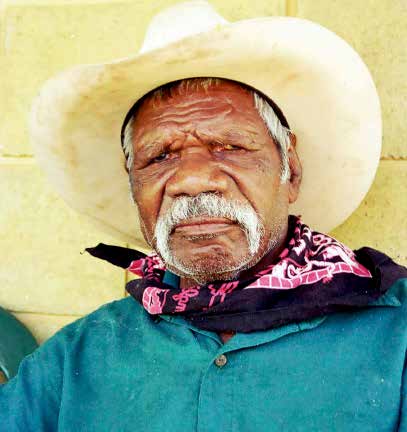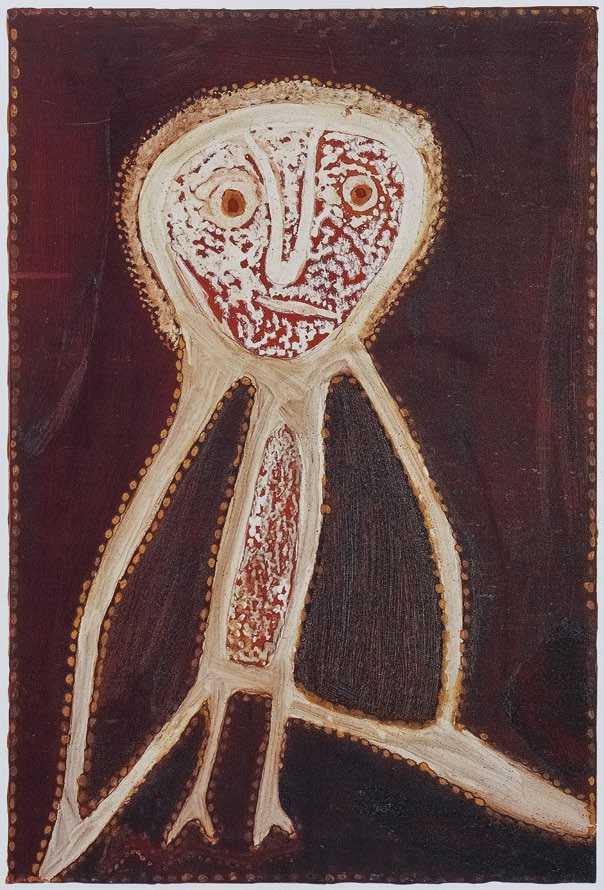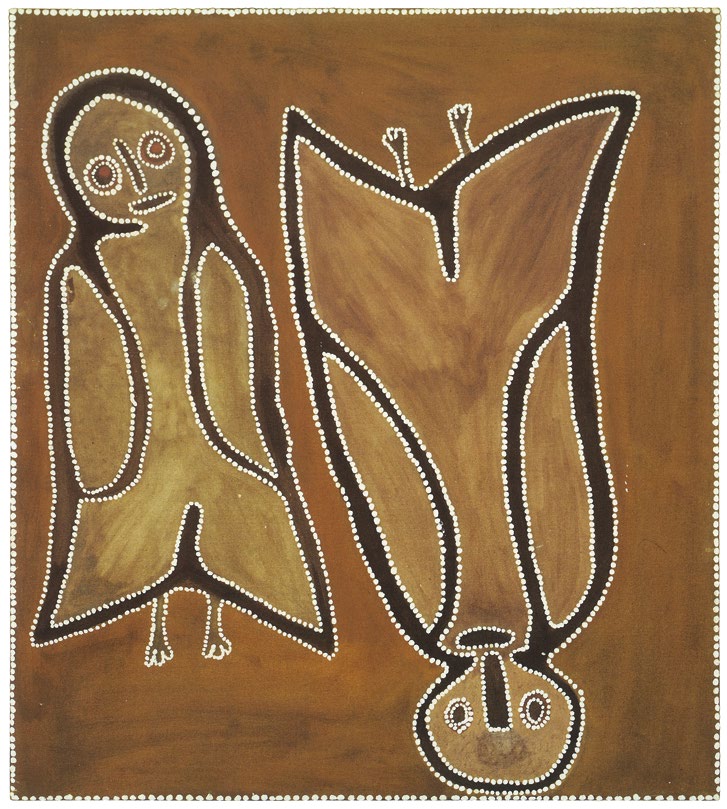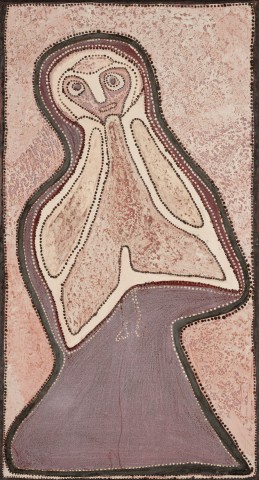TUMBI (OWL), 1989
ROVER THOMAS (JOOLAMA)
earth pigments and natural binders on canvas
120.0 x 64.0 cm
bears inscription verso: 'Rover Thomas/ "Dunbi [sic.] Owl" 1989'
Professor Stephen Muecke, collected on his behalf by Mr Krim Benterrak at Warmun (Turkey Creek) in August/September 1989
John Cruthers, Sydney
Martin Copley AM, Perth
Mossgreen, Melbourne, 20 November 2017, lot 16
Private collection, Melbourne
The Presence of Greatness, Early Wanjina Paintings & Indigenous Art of Western Australia, Tim Klingender Fine Art, Sydney Contemporary, Sydney, 19 - 22 September 2013, cat. 10
Akerman, K., The Presence of Greatness, Early Wanjina Paintings & Indigenous Art of Western Australia, Tim Klingender Fine Art, Sydney Contemporary, Sydney, 2013, pp. 24 - 5 (illus.)
Spunner, S. Tumbi (Owl), 1989, Mossgreen, Melbourne, 20 November 2017, Lot 16, pp 42-3 (illus.)
The Story of Owl (Dumbiny), 1988, earth pigments on canvas, 139.0 x 99.0 cm, in the collection of the Art Gallery of South Australia, Adelaide, illus. in Cumpston, N., and Patton, B., Desert Country: Contemporary Aboriginal Painting, Art Gallery of South Australia, Adelaide, 2010, pp. 90–91
Goolgool the Owl with Four Young, 1988, ochre and gum on canvas, 61.5 x 107.2 cm, in the collection of the Art Gallery of Western Australia, Perth
Grugrugi: Owl, 1989, earth pigments and natural binders on canvas, 100.0 x 90.5 cm, in the Holmes à Court Collection, Perth, illus. in Carrigan, B., Rover Thomas: I Want to Paint, Holmes à Court Gallery, Perth, 2003, cat. 20, p. 41
Owl, 1989, natural earth pigments and natural binders (bush gum) on canvas, 76.0 x 50.5 cm, private collection
and for a related work by Paddy Jaminji see Dumbun (owls), c.1978, illus. in Taylor, L. (ed), Painting the Land Story, National Museum of Australia, Canberra, 1999, pl. 4, p. 19
FINAL DH2022 Aboriginal Catologue (30 March) 05 (1).jpg

The ability of Rover Thomas to engage with the cosmology of many different countries, falling across the many different language groups within the Kimberley gave him a unique perspective on the landscape as a whole. In his deep-rooted knowledge of the past, his role as a custodian of the Kurirr Kurirr ceremony and his highly idiosyncratic style, the past and the present converge in Thomas' enigmatic paintings that explore the history of the land and the ancestral tales. 'Thomas elaborated on the pictorial conventions of the region to articulate a highly personal vision. He introduced an interplay between broad areas of natural colour, unfaltering line, bold forms, and uncompromising composition.’1
Known by several names, the Ancestral Owl is a central figure in Kimberley cosmology and is responsible for a number of ceremonial practices. The Owl has a connection to the Wanjina beings found predominantly in western and northern Kimberley. Sometimes interrelated with the Wanjina are the terms Ungud/Galeru (the force in nature manifest as the rainbow Serpent).2 The renditions of owls by Rover Thomas can be read as a link between his original desert heritage and that of the east Kimberley, within the milieu of general Kimberley cosmology. Mapping out the land in strong earthy tones and abstract shapes, Thomas carefully balances the landscape and the narrative. He would often utilise two modes of perspective, an aerial view of the roads and the countryside and a profile view of landscape features and figures, as demonstrated in Tumbi (Owl), 1989, contrasting the figure of the bird against the block colours. One of the few subjects that the artist rendered in a naturalistic fashion, the features of the owl are delineated by daubs of white paint, as is the background. This stippling which has become typical of Thomas's celebrated works, references his birthplace in the desert and the art of that region.
OWL.jpg

Kim Akerman likens the mythology of the Wanjina to a Greek tragedy apparent in the saga of the Kurirr Kurirr in both the story of the great battle between Wanjinas and humans and also the odysseys of various Wanjinas as they returned from the arena of battle to their respective homes.
‘Like the Illiad of Ancient Greece, a great Wanjina saga deals with hubris and nemesis, human frailties, conflicts with the Gods and subsequent dispersal of the Wanjina folk, across the northern Kimberley. The story of Tumbi relates to a palga dance cycle composed by Worrorra elder, Wattie Ngerdu at Mowanjum in the 1960s. Rover Thomas has painted the baby owl who belonged to the Wanjina who in the opening events of this sage was tormented by two boys. In retaliation and to punish the cruel and thoughtless humans, the Wanjinas, under the leadership of Wanalirri - a senior Wanjina from the country east of Gibb River, who had been offended by the shame suffered by the owl – sent a down a great flood. This palga was shown extensively within the Kimberley and farther afield and no doubt influenced Rover, although Rover located the owl's home country as lying in the Osmond Valley on Texas Downs Station.3
There are at least fifteen other significant paintings executed by Rover Thomas that depict owls and this work is exceptional in the quality of the brushwork and layout. Dr Suzanne Spunner has commented, ‘Rover Thomas does not depict owls in flight, but rather as still and watchful from a canonical perspective to clearly show their distinguishing features. Many of his owls float free in an imperial space, while others hide away, secreted in hollows and crevices. The owls is framed or enclosed by a tree hollow which visually functions as a plinth for a sculpture, or an enclosure or niche to hold a revered figure. This work, Tumbi (Owl), 1989 is most comparable to the Holmes a Court Collection work Grugugi Owl 1989 a double owl in the playing card format top to tail which was painted for Mary Macha,’ 4 Noted Kurirrkurirr artist Paddy Jaminji and later other painters have also produced paintings depicting Tumbi. 5
owl3.jpg

1. Caruana, W., Aboriginal Art, Thames and Hudson, New York, 1993, p. 177
2. Ryan J. and Akerman, K., Images of Power: Aboriginal Art of the Kimberley, National Gallery of Victoria, Melbourne, 1993, p. 13
3. Information supplied in correspondence with Kim Akerman
4. Spunner, S. Tumbi (Owl) 1989, Mossgreen, Melbourne, 20 November 2017, p.42 and on the author's website https://www.suzannespunner.com/art-authentication
5. Information supplied in correspondence with Kim Akerman
We are grateful to Kim Akerman and Dr Suzanne Spunner for their assistance with this catalogue entry.
